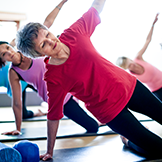
The hip is an important, yet underrecognized joint. It’s not simply a point of mobility, it’s a source of great power and strength in our physiology. When NBA superstar Stephen Curry embarked on a training routine following a serious ankle injury, his comeback strategy was to focus on his hips. “Shiftiness is an ankle strategy, but power comes from the hips,” Keke Lyles, Curry’s medical trainer told ESPN in an interview. “We wanted to teach Steph how to load his hips to help unload his ankles.”
Curry’s training regimen was obviously effective, as his fame and success grew with his physical strength. The hip is, in fact, the strongest joint in the human body. Surrounding the bony joint is a mighty group of 17 muscles, which are categorized as gluteal, lateral rotator, adductor, and iliopsoas. If you’ve ever heard about exercises for the hip flexors or hip extensors, these are the muscle groups in question.
The individual muscles in the hip region serve different purposes and are responsible for supporting the hip’s various movements. They are also interconnected with our spine, legs and abdomen. For example, when your hip flexors are too tight, they often cause back pain because muscles are pulling on the lower spine.
Redefining the Core
It’s because of that interconnectedness that healthy hips and a strong core yield reciprocal benefits. In the Curry example, he shifted a physical burden from his ankles, which were previously doing all the work and being damaged as a result, to his hip muscles. Curry’s story is interesting in that the hip muscle groups are not often considered to be core muscles. However, the principle holds true regardless of what we name the muscles. If you build your core strength, you will build your hip strength. And the combined result will make your body more efficient by redirecting the responsibility of bearing weight and movement from your joints to the muscle centers known as your core, hip flexors and extensors. Boosting core strength will help reduce wear and tear on the hip joint itself, too.
The relationship between your core and your hips is so symbiotic that many of the exercises for core-building are also suggested by trainers and physical therapists for hip strength. The best example is likely the side plank. Your MOSH Sports Medicine Team is an excellent resource to learn a side plank as well as other core and hip exercises.
The Law of Inertia
When it comes to hip health, movement is key. If you buy a new car, park it in a garage and let it sit for 20 years without driving it, over time, the engine and the wheels will seize. Your hips are similar. Hip problems are on the rise and the culprit has a lot to do with inactivity in our culture.
Women’s Health Magazine wrote an article on the importance of maintaining hip health. In it, hips are described as a workout secret weapon but the hazards of sitting idle are clear: “Sitting throws your hips into a crunched position, shortening and tightening the muscles there—namely your hip flexors, which run from your lower back to the top of your thighs and are responsible for lifting your legs.”
Simply put: lack of physical activity will cause hip pain. This doesn’t mean you’re doomed if you hold a desk job or unathletic. It does mean you need to be cognizant of the risks of inactivity and that you should seek a balance in your daily routine. If you sit at a desk or stand still for prolonged periods of time, take regular breaks and go for short walks. If you can sneak away to do some hip lifts or split squats, do it. And when you’re not at work, yes, there is a long list of simple core strengthening activities you can do on a daily basis regardless of your level of athleticism.
The Importance of Hip & Pelvic Stability
According to Princeton University Athletic Medicine, “Lower back, hip, knee and ankle problems can be affected by inefficient pelvic and/or hip stabilization.” While it’s important to stay active and keep the hips moving, it’s equally important to keep them stable. Your hip muscles are in charge of stabilization, which means they hold everything in place while the body is moving. If your pelvis is misaligned, it could be because your hip stabilization is weak. And yes, this is once again tied to core strength. If this biomechanic system of interconnectedness is out of whack, imbalance, and injury are probable.
A great core strength-building option to improve hip and pelvic stabilization is pilates. Pilates is a system of exercises that focuses on strength, flexibility, and posture. Whatever routine you chose, you want to teach your hips to manage mobility with stability and strength. It can be a complicated balance, which is why it’s always best to talk to your doctor first before engaging in any activities you hope will solve your hip issues.